2007 CHEVROLET AVEO washer fluid
[x] Cancel search: washer fluidPage 240 of 436
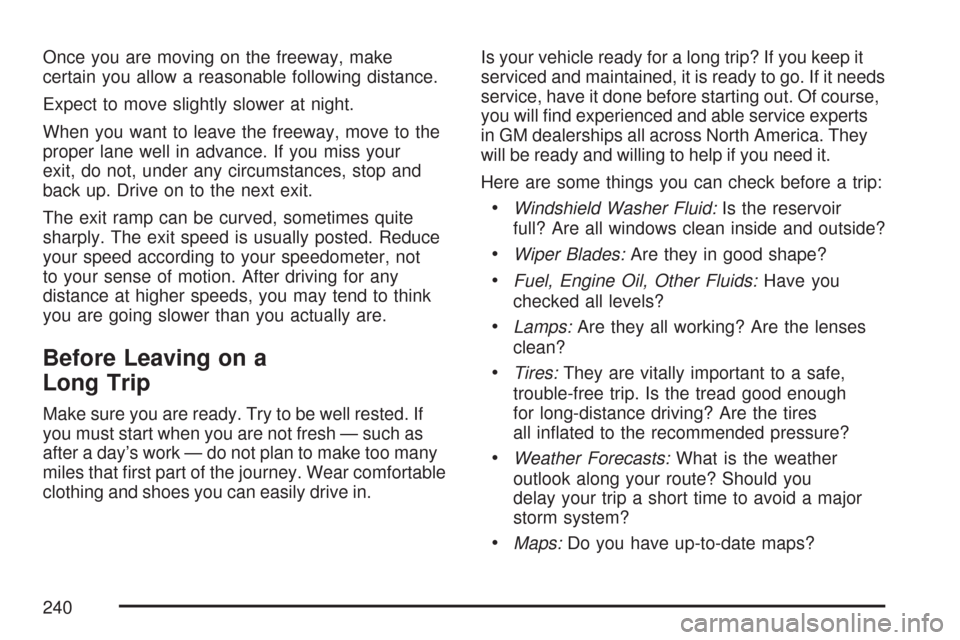
Once you are moving on the freeway, make
certain you allow a reasonable following distance.
Expect to move slightly slower at night.
When you want to leave the freeway, move to the
proper lane well in advance. If you miss your
exit, do not, under any circumstances, stop and
back up. Drive on to the next exit.
The exit ramp can be curved, sometimes quite
sharply. The exit speed is usually posted. Reduce
your speed according to your speedometer, not
to your sense of motion. After driving for any
distance at higher speeds, you may tend to think
you are going slower than you actually are.
Before Leaving on a
Long Trip
Make sure you are ready. Try to be well rested. If
you must start when you are not fresh — such as
after a day’s work — do not plan to make too many
miles that first part of the journey. Wear comfortable
clothing and shoes you can easily drive in.Is your vehicle ready for a long trip? If you keep it
serviced and maintained, it is ready to go. If it needs
service, have it done before starting out. Of course,
you will find experienced and able service experts
in GM dealerships all across North America. They
will be ready and willing to help if you need it.
Here are some things you can check before a trip:
•Windshield Washer Fluid:Is the reservoir
full? Are all windows clean inside and outside?
•Wiper Blades:Are they in good shape?
•Fuel, Engine Oil, Other Fluids:Have you
checked all levels?
•Lamps:Are they all working? Are the lenses
clean?
•Tires:They are vitally important to a safe,
trouble-free trip. Is the tread good enough
for long-distance driving? Are the tires
all inflated to the recommended pressure?
•Weather Forecasts:What is the weather
outlook along your route? Should you
delay your trip a short time to avoid a major
storm system?
•Maps:Do you have up-to-date maps?
240
Page 261 of 436

Service........................................................ 264
Accessories and Modifications................... 264
California Proposition 65 Warning.............. 265
Doing Your Own Service Work.................. 265
Adding Equipment to the Outside of
Your Vehicle.......................................... 266
Fuel............................................................. 266
Gasoline Octane........................................ 266
Gasoline Specifications.............................. 266
California Fuel........................................... 267
Additives................................................... 267
Fuels in Foreign Countries........................ 268
Filling the Tank......................................... 269
Filling a Portable Fuel Container............... 272
Checking Things Under the Hood.............. 273
Hood Release........................................... 274
Engine Compartment Overview.................. 276
Engine Oil................................................. 277
Engine Air Cleaner/Filter............................ 281
Automatic Transaxle Fluid......................... 283Manual Transaxle Fluid............................. 285
Hydraulic Clutch........................................ 286
Engine Coolant.......................................... 287
Coolant Surge Tank Pressure Cap............ 290
Engine Overheating................................... 290
Cooling System......................................... 292
Power Steering Fluid................................. 297
Windshield Washer Fluid........................... 298
Brakes...................................................... 299
Battery...................................................... 303
Jump Starting............................................ 304
Headlamp Aiming........................................ 309
Bulb Replacement....................................... 309
Halogen Bulbs........................................... 309
Headlamps (Hatchback)............................. 310
Headlamps (Sedan)................................... 311
Front Turn Signal and Parking Lamps
(Hatchback)............................................ 312
Front Turn Signal and Parking Lamps
(Sedan).................................................. 313
Section 5 Service and Appearance Care
261
Page 277 of 436
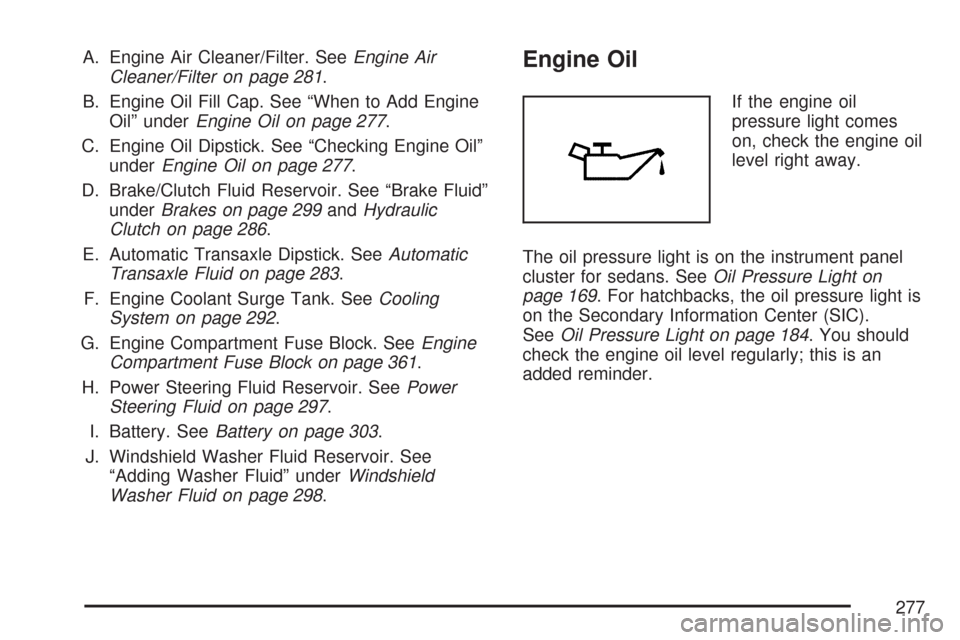
A. Engine Air Cleaner/Filter. SeeEngine Air
Cleaner/Filter on page 281.
B. Engine Oil Fill Cap. See “When to Add Engine
Oil” underEngine Oil on page 277.
C. Engine Oil Dipstick. See “Checking Engine Oil”
underEngine Oil on page 277.
D. Brake/Clutch Fluid Reservoir. See “Brake Fluid”
underBrakes on page 299andHydraulic
Clutch on page 286.
E. Automatic Transaxle Dipstick. SeeAutomatic
Transaxle Fluid on page 283.
F. Engine Coolant Surge Tank. SeeCooling
System on page 292.
G. Engine Compartment Fuse Block. SeeEngine
Compartment Fuse Block on page 361.
H. Power Steering Fluid Reservoir. SeePower
Steering Fluid on page 297.
I. Battery. SeeBattery on page 303.
J. Windshield Washer Fluid Reservoir. See
“Adding Washer Fluid” underWindshield
Washer Fluid on page 298.Engine Oil
If the engine oil
pressure light comes
on, check the engine oil
level right away.
The oil pressure light is on the instrument panel
cluster for sedans. SeeOil Pressure Light on
page 169. For hatchbacks, the oil pressure light is
on the Secondary Information Center (SIC).
SeeOil Pressure Light on page 184. You should
check the engine oil level regularly; this is an
added reminder.
277
Page 298 of 436
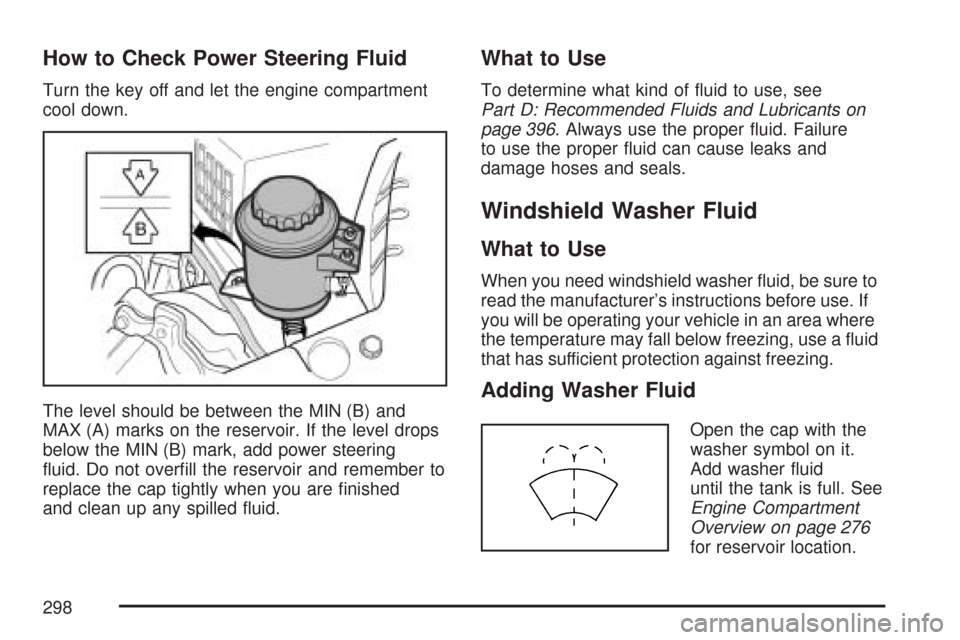
How to Check Power Steering Fluid
Turn the key off and let the engine compartment
cool down.
The level should be between the MIN (B) and
MAX (A) marks on the reservoir. If the level drops
below the MIN (B) mark, add power steering
fluid. Do not overfill the reservoir and remember to
replace the cap tightly when you are finished
and clean up any spilled fluid.
What to Use
To determine what kind of fluid to use, see
Part D: Recommended Fluids and Lubricants on
page 396. Always use the proper fluid. Failure
to use the proper fluid can cause leaks and
damage hoses and seals.
Windshield Washer Fluid
What to Use
When you need windshield washer fluid, be sure to
read the manufacturer’s instructions before use. If
you will be operating your vehicle in an area where
the temperature may fall below freezing, use a fluid
that has sufficient protection against freezing.
Adding Washer Fluid
Open the cap with the
washer symbol on it.
Add washer fluid
until the tank is full. See
Engine Compartment
Overview on page 276
for reservoir location.
298
Page 299 of 436
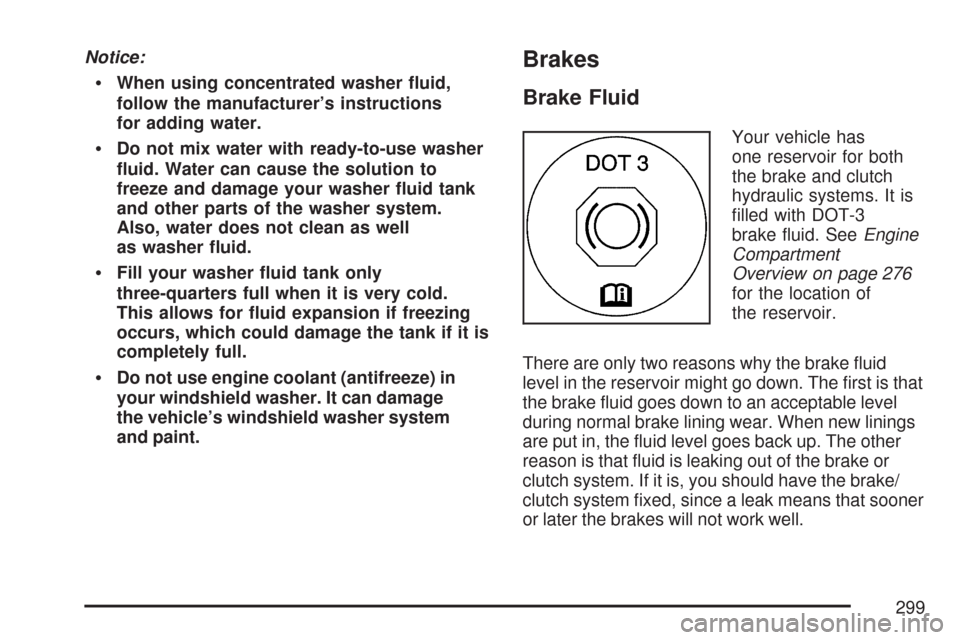
Notice:
When using concentrated washer �uid,
follow the manufacturer’s instructions
for adding water.
Do not mix water with ready-to-use washer
�uid. Water can cause the solution to
freeze and damage your washer �uid tank
and other parts of the washer system.
Also, water does not clean as well
as washer �uid.
Fill your washer �uid tank only
three-quarters full when it is very cold.
This allows for �uid expansion if freezing
occurs, which could damage the tank if it is
completely full.
Do not use engine coolant (antifreeze) in
your windshield washer. It can damage
the vehicle’s windshield washer system
and paint.
Brakes
Brake Fluid
Your vehicle has
one reservoir for both
the brake and clutch
hydraulic systems. It is
filled with DOT-3
brake fluid. SeeEngine
Compartment
Overview on page 276
for the location of
the reservoir.
There are only two reasons why the brake fluid
level in the reservoir might go down. The first is that
the brake fluid goes down to an acceptable level
during normal brake lining wear. When new linings
are put in, the fluid level goes back up. The other
reason is that fluid is leaking out of the brake or
clutch system. If it is, you should have the brake/
clutch system fixed, since a leak means that sooner
or later the brakes will not work well.
299
Page 375 of 436
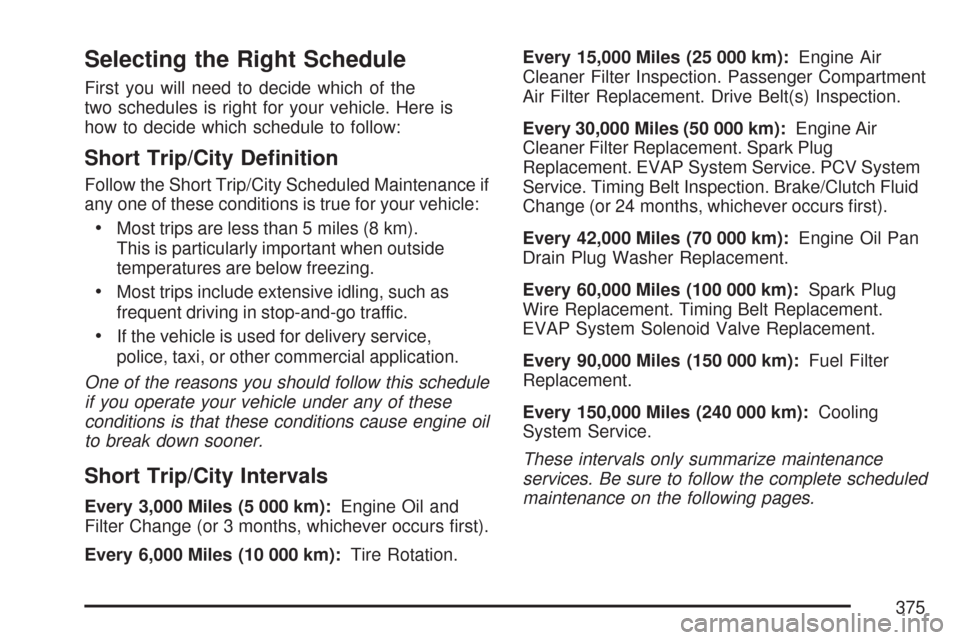
Selecting the Right Schedule
First you will need to decide which of the
two schedules is right for your vehicle. Here is
how to decide which schedule to follow:
Short Trip/City De�nition
Follow the Short Trip/City Scheduled Maintenance if
any one of these conditions is true for your vehicle:
•Most trips are less than 5 miles (8 km).
This is particularly important when outside
temperatures are below freezing.
•Most trips include extensive idling, such as
frequent driving in stop-and-go traffic.
•If the vehicle is used for delivery service,
police, taxi, or other commercial application.
One of the reasons you should follow this schedule
if you operate your vehicle under any of these
conditions is that these conditions cause engine oil
to break down sooner.
Short Trip/City Intervals
Every 3,000 Miles (5 000 km):Engine Oil and
Filter Change (or 3 months, whichever occurs first).
Every 6,000 Miles (10 000 km):Tire Rotation.Every 15,000 Miles (25 000 km):Engine Air
Cleaner Filter Inspection. Passenger Compartment
Air Filter Replacement. Drive Belt(s) Inspection.
Every 30,000 Miles (50 000 km):Engine Air
Cleaner Filter Replacement. Spark Plug
Replacement. EVAP System Service. PCV System
Service. Timing Belt Inspection. Brake/Clutch Fluid
Change (or 24 months, whichever occurs first).
Every 42,000 Miles (70 000 km):Engine Oil Pan
Drain Plug Washer Replacement.
Every 60,000 Miles (100 000 km):Spark Plug
Wire Replacement. Timing Belt Replacement.
EVAP System Solenoid Valve Replacement.
Every 90,000 Miles (150 000 km):Fuel Filter
Replacement.
Every 150,000 Miles (240 000 km):Cooling
System Service.
These intervals only summarize maintenance
services. Be sure to follow the complete scheduled
maintenance on the following pages.
375
Page 376 of 436
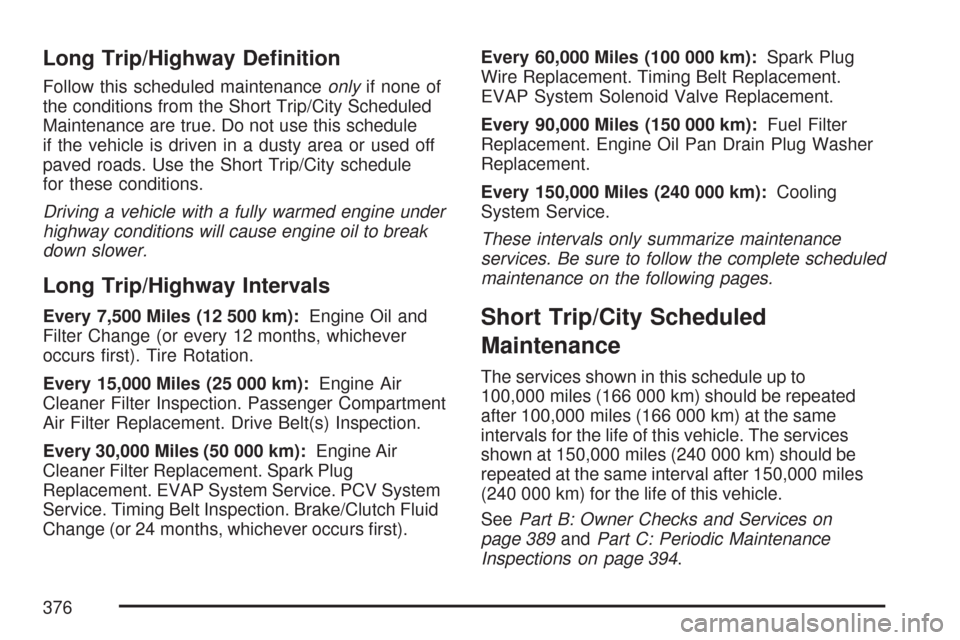
Long Trip/Highway De�nition
Follow this scheduled maintenanceonlyif none of
the conditions from the Short Trip/City Scheduled
Maintenance are true. Do not use this schedule
if the vehicle is driven in a dusty area or used off
paved roads. Use the Short Trip/City schedule
for these conditions.
Driving a vehicle with a fully warmed engine under
highway conditions will cause engine oil to break
down slower.
Long Trip/Highway Intervals
Every 7,500 Miles (12 500 km):Engine Oil and
Filter Change (or every 12 months, whichever
occurs first). Tire Rotation.
Every 15,000 Miles (25 000 km):Engine Air
Cleaner Filter Inspection. Passenger Compartment
Air Filter Replacement. Drive Belt(s) Inspection.
Every 30,000 Miles (50 000 km):Engine Air
Cleaner Filter Replacement. Spark Plug
Replacement. EVAP System Service. PCV System
Service. Timing Belt Inspection. Brake/Clutch Fluid
Change (or 24 months, whichever occurs first).Every 60,000 Miles (100 000 km):Spark Plug
Wire Replacement. Timing Belt Replacement.
EVAP System Solenoid Valve Replacement.
Every 90,000 Miles (150 000 km):Fuel Filter
Replacement. Engine Oil Pan Drain Plug Washer
Replacement.
Every 150,000 Miles (240 000 km):Cooling
System Service.
These intervals only summarize maintenance
services. Be sure to follow the complete scheduled
maintenance on the following pages.Short Trip/City Scheduled
Maintenance
The services shown in this schedule up to
100,000 miles (166 000 km) should be repeated
after 100,000 miles (166 000 km) at the same
intervals for the life of this vehicle. The services
shown at 150,000 miles (240 000 km) should be
repeated at the same interval after 150,000 miles
(240 000 km) for the life of this vehicle.
SeePart B: Owner Checks and Services on
page 389andPart C: Periodic Maintenance
Inspections on page 394.
376
Page 389 of 436
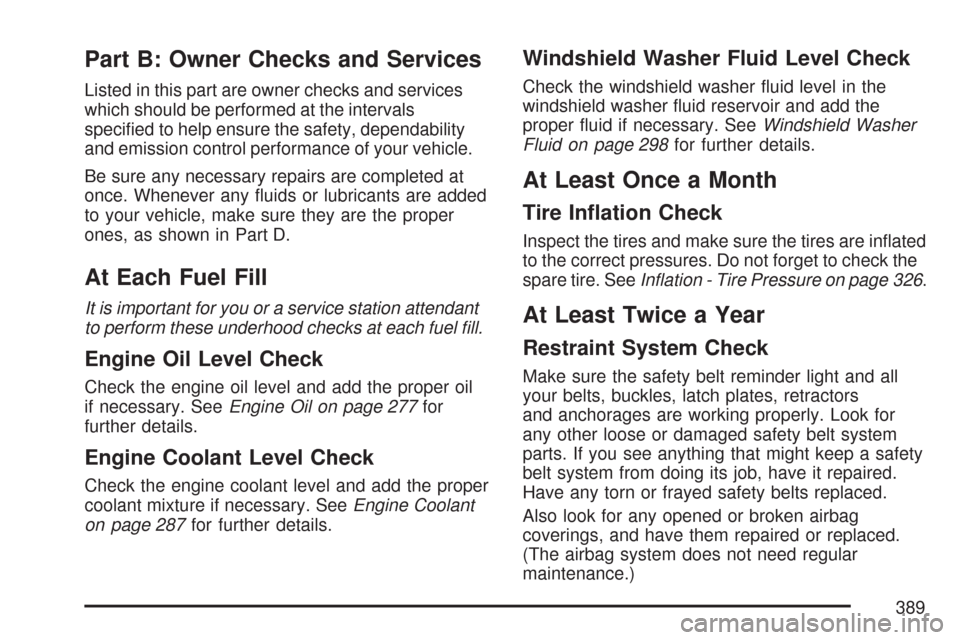
Part B: Owner Checks and Services
Listed in this part are owner checks and services
which should be performed at the intervals
specified to help ensure the safety, dependability
and emission control performance of your vehicle.
Be sure any necessary repairs are completed at
once. Whenever any fluids or lubricants are added
to your vehicle, make sure they are the proper
ones, as shown in Part D.
At Each Fuel Fill
It is important for you or a service station attendant
to perform these underhood checks at each fuel fill.
Engine Oil Level Check
Check the engine oil level and add the proper oil
if necessary. SeeEngine Oil on page 277for
further details.
Engine Coolant Level Check
Check the engine coolant level and add the proper
coolant mixture if necessary. SeeEngine Coolant
on page 287for further details.
Windshield Washer Fluid Level Check
Check the windshield washer fluid level in the
windshield washer fluid reservoir and add the
proper fluid if necessary. SeeWindshield Washer
Fluid on page 298for further details.
At Least Once a Month
Tire In�ation Check
Inspect the tires and make sure the tires are inflated
to the correct pressures. Do not forget to check the
spare tire. SeeInflation - Tire Pressure on page 326.
At Least Twice a Year
Restraint System Check
Make sure the safety belt reminder light and all
your belts, buckles, latch plates, retractors
and anchorages are working properly. Look for
any other loose or damaged safety belt system
parts. If you see anything that might keep a safety
belt system from doing its job, have it repaired.
Have any torn or frayed safety belts replaced.
Also look for any opened or broken airbag
coverings, and have them repaired or replaced.
(The airbag system does not need regular
maintenance.)
389